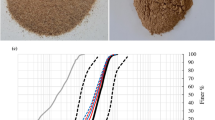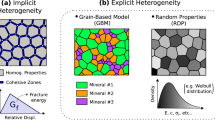Abstract
The stress–strain response of over-consolidated soft soil, e.g., clay, is dependent on its pre-consolidation history and material state. In this study, a state-dependent constitutive model for over-consolidated soft soils is proposed by extending the fractional plasticity originally developed for granular soil. The state-dependent stress-dilatancy and peak failure behaviour of over-consolidated soft soil are analytically captured through stress-fractional gradient of the current yielding surface. In addition, a reference yielding surface describing the pre-consolidation history of soft soil is proposed. A combined hardening rule expressed as a function of both the incremental plastic volumetric and shear strains is suggested. To validate the proposed model, a series of drained and undrained test results of different soft soils with a wide range of over-consolidation ratios are simulated and compared. It is found that without using additional plastic potentials and state parameters, the developed fractional model can capture the state-dependent hardening and softening responses of soft soils subjected to different over-consolidation states.
















Similar content being viewed by others
Availability of data and material
All the data used in this study can be found in the relevant literatures, which has been cited properly besides each dataset.
Code availability
Codes related to this study can be provided upon proper request.
References
Singh RP, Nimbalkar S, Singh S, Choudhury D (2019) Field assessment of railway ballast degradation and mitigation using geotextile. Geotext Geomembr. https://doi.org/10.1016/j.geotexmem.2019.11.013
El Jirari S, Wong H, Deleruyelle F, Branque D, Berthoz N, Leo C (2020) Analytical modelling of a tunnel accounting for elastoplastic unloading and reloading with reverse yielding and plastic flow. Comput Geotech 121:103441. https://doi.org/10.1016/j.compgeo.2020.103441
Wu Y, Zhou X, Gao Y, Zhang L, Yang J (2019) Effect of soil variability on bearing capacity accounting for non-stationary characteristics of undrained shear strength. Comput Geotech 110:199–210. https://doi.org/10.1016/j.compgeo.2019.02.003
Yin ZY, Chang CS (2009) Microstructural modelling of stress-dependent behaviour of clay. Int J Solids Struct 46(6):1373–1388. https://doi.org/10.1016/j.ijsolstr.2008.11.006
Nakai T, Matsuoka H, Okuno N, Tsuzuki K (1986) True triaxial tests on normally consolidated clay and analysis of the observed shear behaviour using elastoplastic constitutive models. Soils Found 26(4):67–78. https://doi.org/10.3208/sandf1972.26.4_67
Whittle AJ (1993) Evaluation of a constitutive model for overconsolidated clays. Géotechnique 43:289–313. https://doi.org/10.1680/geot.1993.43.2.289
Liu MD, Carter JP (2002) A structured Cam Clay model. Can Geotech J 39(6):1313–1332. https://doi.org/10.1139/t02-069
Pestana JM, Whittle AJ, Gens A (2002) Evaluation of a constitutive model for clays and sands: part II—clay behaviour. Int J Numer Anal Meth Geomech 26(11):1123–1146. https://doi.org/10.1002/nag.238
Roscoe K, Schofield A, Thurairajah A (1963) Yielding of clays in states wetter than critical. Géotechnique 13(3):211–240
Yao Y, Liu L, Luo T, Tian Y, Zhang JM (2019) Unified hardening (UH) model for clays and sands. Comput Geotech 110:326–343. https://doi.org/10.1016/j.compgeo.2019.02.024
Yao Y, Hou W, Zhou AN (2009) UH model: three-dimensional unified hardening model for overconsolidated clays. Géotechnique 59(5):451–469. https://doi.org/10.1680/geot.2007.00029
Matsuoka H, Yao Y, Sun D (1999) The cam-clay models revised by the SMP criterion. Soils Found 39(1):81–95. https://doi.org/10.3208/sandf.39.81
Nakai T, Hinokio M (2004) A simple elastoplastic model for normally and overconsolidated soils with unified material parameters. Soils Found 44(2):53–70. https://doi.org/10.3208/sandf.44.2_53
Shi XS, Nie J, Zhao J, Gao Y (2020) A homogenization equation for the small strain stiffness of gap-graded granular materials. Comput Geotech 121:103440. https://doi.org/10.1016/j.compgeo.2020.103440
Shi XS, Zhao J (2020) Practical estimation of compression behavior of clayey/silty sands using equivalent void-ratio concept. J Geotech Geoenviron Eng 146(6):04020046. https://doi.org/10.1061/(ASCE)GT.1943-5606.0002267
Jocković S, Vukićević M (2017) Bounding surface model for overconsolidated clays with new state parameter formulation of hardening rule. Comput Geotech 83:16–29. https://doi.org/10.1016/j.compgeo.2016.10.013
Lu D, Liang J, Du X, Ma C, Gao Z (2019) Fractional elastoplastic constitutive model for soils based on a novel 3D fractional plastic flow rule. Comput Geotech 105:277–290. https://doi.org/10.1016/j.compgeo.2018.10.004
Wichtmann T, Triantafyllidis T (2017) Monotonic and cyclic tests on kaolin: a database for the development, calibration and verification of constitutive models for cohesive soils with focus to cyclic loading. Acta Geotech. https://doi.org/10.1007/s11440-017-0588-3
Ye GL, Ye B, Zhang F (2014) Strength and dilatancy of overconsolidated clays in drained true triaxial tests. J Geotech Geoenviron Eng. https://doi.org/10.1061/(ASCE)GT.1943-5606.0001060
Yang ZX, Xu TT, Li XS (2019) J2-deformation type model coupled with state dependent dilatancy. Comput Geotech 105:129–141. https://doi.org/10.1016/j.compgeo.2018.09.018
Yin ZY, Xu Q, Hicher PY (2013) A simple critical-state-based double-yield-surface model for clay behavior under complex loading. Acta Geotech 8(5):509–523. https://doi.org/10.1007/s11440-013-0206-y
Xiao Y, Desai CS (2019) Constitutive modeling for overconsolidated clays based on disturbed state concept. I: theory. Int J Geomech. https://doi.org/10.1061/(ASCE)GM.1943-5622.0001474
Zhang S, Ye G, Wang J (2018) Elastoplastic model for overconsolidated clays with focus on volume change under general loading conditions. Int J Geomech 18(3):04018005. https://doi.org/10.1061/(ASCE)GM.1943-5622.0001101
Been K, Jefferies MG (1985) A state parameter for sands. Géotechnique 35(2):99–112. https://doi.org/10.1016/0148-9062(85)90263-3
Sun Y, Gao Y, Shen Y (2019) Mathematical aspect of the state-dependent stress-dilatancy of granular soil under triaxial loading. Géotechnique 69(2):158–165. https://doi.org/10.1680/jgeot.17.t.029
Sun Y, Sumelka W (2019) State-dependent fractional plasticity model for the true triaxial behaviour of granular soil. Arch Mech 71(1):23–47. https://doi.org/10.24423/aom.3084
Sumelka W, Nowak M (2018) On a general numerical scheme for the fractional plastic flow rule. Mech Mater 116:120–129. https://doi.org/10.1016/j.mechmat.2017.02.005
Sumelka W (2014) A note on non-associated Drucker–Prager plastic flow in terms of fractional calculus. J Theor Appl Mech 52(2):571–574. https://doi.org/10.15632/jtam-pl.53.4.959
Sumelka W (2014) Fractional viscoplasticity. Mech Res Commun 56:31–36. https://doi.org/10.1016/j.mechrescom.2013.11.005
Sumelka W, Nowak M (2016) Non-normality and induced plastic anisotropy under fractional plastic flow rule: a numerical study. Int J Numer Anal Methods Geomech 40(5):651–675. https://doi.org/10.1002/nag.2421
Liang J, Lu D, Zhou X, Du X, Wu W (2019) Non-orthogonal elastoplastic constitutive model with the critical state for clay. Comput Geotech 116:103200. https://doi.org/10.1016/j.compgeo.2019.103200
Liang J, Lu D, Du X, Wu W, Ma C (2020) Non-orthogonal elastoplastic constitutive model for sand with dilatancy. Comput Geotech 118:103329. https://doi.org/10.1016/j.compgeo.2019.103329
Sun Y, Sumelka W, Gao Y (2020) Advantages and limitations of an α-plasticity model for sand. Acta Geotech 15:1423–1437. https://doi.org/10.1007/s11440-019-00877-9
Sun Y, Wichtmann T, Sumelka W, Kan M (2020) Karlsruhe fine sand under monotonic and cyclic loads: modelling and validation. Soil Dyn Earthq Eng 133:106119. https://doi.org/10.1016/j.soildyn.2020.106119
Hardin BO, Blandford GE (1989) Elasticity of particulate materials. J Geotech Eng 115(6):788–805. https://doi.org/10.1061/(ASCE)0733-9410(1989)115:6(788)
Pastor M, Zienkiewicz OC, Chan AHC (1990) Generalized plasticity and the modelling of soil behaviour. Int J Numer Anal Methods Geomech 14(3):151–190. https://doi.org/10.1002/nag.1610140302
Sun Y, Nimbalkar S (2019) Stress-fractional soil model with reduced elastic region. Soils Found 59(6):2007–2023. https://doi.org/10.1016/j.sandf.2019.10.001
Sun Y, Zheng C (2019) Fractional-order modelling of state-dependent non-associated behaviour of soil without using state variable and plastic potential. Adv Differ Equ 2019(83):1–18. https://doi.org/10.1186/s13662-019-2040-5
Schofield A, Wroth P (1968) Critical state soil mechanics. McGraw-Hill London, New York
Wang ZL, Dafalias YF, Shen CK (1990) Bounding surface hypoplasticity model for sand. J Eng Mech 116(5):983–1001
Tafili M (2020) Triantafyllidis T state-dependent dilatancy of soils: experimental evidence and constitutive modeling. In: Triantafyllidis T (ed) Recent developments of soil mechanics and geotechnics in theory and practice. Springer, Cham, pp 54–84
Yu HS, Khong CD, Wang J, Zhang G (2005) Experimental evaluation and extension of a simple critical state model for sand. Granul Matter 7(4):213–225. https://doi.org/10.1007/s10035-005-0209-y
Gens A (1982) Stress–strain and strength of a low plasticity clay. Imperial College, London University, London
Ladd CC, Varallyay J (1965) The influence of the stress system on the behaviour of saturated clays during undrained shear (trans: Engineering DoC). MIT, Cambridge
Biarez J, Hicher PY (1994) Elementary mechanics of soil behaviour. Balkema, Rotterdam
Zervoyannis C (1982) Étude synthétique des propriétés mécaniques des argiles saturées et des sables sur chemin oedométrique et triaxial de révolution. École centrale Paris, Paris
Funding
The first author would like to thank Prof. Wen Chen for the invaluable inspiration. The financial support from the National Natural Science Foundation of China (Grant No. 41630638), the National Science Centre, Poland (Grant No. 2017/27/B/ST8/00351) and the Alexander Von Humboldt Research Foundation are appreciated.
Author information
Authors and Affiliations
Corresponding author
Ethics declarations
Conflict of interest
The authors declare that there is no conflict of interest.
Additional information
Publisher's Note
Springer Nature remains neutral with regard to jurisdictional claims in published maps and institutional affiliations.
Appendix
Appendix
Following Matsuoka et al. [12], the critical-state stress ratio, \(M\left( \theta \right)\), is defined as:
where Mc is the slope of the CSL in the \(p^{\prime} - q\) plane and \(\Psi\) is a function of the Lode’s angle (θ), which can be defined as:
where \(\phi_{c}\) is the critical-state friction angle obtained under triaxial compression.
Rights and permissions
About this article
Cite this article
Sun, Y., Sumelka, W. & Gao, Y. Fractional plasticity for over-consolidated soft soil. Meccanica 57, 845–859 (2022). https://doi.org/10.1007/s11012-021-01343-1
Received:
Accepted:
Published:
Issue Date:
DOI: https://doi.org/10.1007/s11012-021-01343-1




